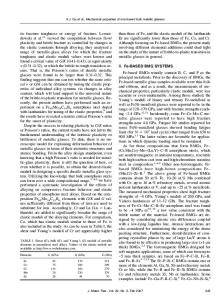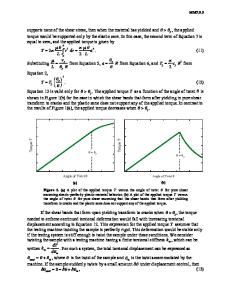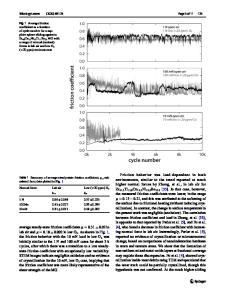Mechanical Properties of Bulk Metallic Glasses
- PDF / 381,858 Bytes
- 4 Pages / 585 x 783 pts Page_size
- 58 Downloads / 443 Views
Properties of Bulk Metallic Glasses
A.R. Yavari, J.J. Lewandowski, and J. Eckert Abstract In the absence of dislocation-mediated crystallographic slip, room-temperature deformation in metallic glasses occurs in thin shear bands initially only ~10 nm thick. A sharp drop in viscosity (shear softening) occurs in deformed glassy matter and facilitates additional flow in existing shear bands. This further localization of plastic flow leads to shearing-off failure without any significant macroscopic plasticity. However, whereas most bulk metallic glasses fail in this manner, some undergo surprisingly extensive plastic deformation (in some cases, up to 50% or more) in compression or bending. When this occurs, the flow is “jerky,” as indicated by serrated stress–strain curves. Each serration may correspond to the emission of a shear band that then ceases to operate, at least temporarily, despite the predicted shear softening. As elastic energy is converted to heat during shear, temperatures rise sharply at or near shear bands. This heating may lead to the growth of nanocrystals that then block propagation of shear bands and cracks. The understanding of the dependence of mechanical response of metallic glasses on intrinsic (elastic constants, chemistry) and extrinsic factors (shapes, flaws) is the subject of intense current interest.
Introduction
Mechanical Strength
Recent breakthroughs in materials engineering have generated complex Zr-, Ti-, Cu-, Fe-, Ni-, La-, Pd-, Pt-, and Mg-based alloys that retain a glassy state in bulk form via conventional ingot casting. These materials are known as bulk metallic glasses, or BMGs. Due to their 2% elastic strain range (as compared with 0.2% for crystalline materials), BMGs currently have the best known values for the performance index σ2/E and good values of the index σ2/ρE (where σ, ρ, and E are respectively the yield strength, mass density, and Young’s modulus). Exploitation of BMGs for structural applications is favored by their high strength and high elastic strain, but hindered by their lack of plasticity. Recent work, reviewed in this article, shows that impressive improvements in plasticity— for example, 50% plastic strain in compression—can be achieved by a variety of methods such as optimization of the elastic constants or partial crystallization within the glassy matrix.
Because they do not possess slip systems and lattice dislocations as in crystalline materials, metallic glasses manifest elastic deformation of more than 2% before yielding at strains that scale with temperature,1 and correspondingly, their yield strengths can be well in excess of those of conventional structural materials. BMG rods of cobalt-based compositions Co-FeTa-B2 and Co-Fe-Ta-B-Mo3 achieve record room-temperature compressive fracture strengths (σf) of 5.2 GPa and 5.5 GPa, respectively, approaching the theoretical strength. Many Fe-based BMGs show σf of ~4 GPa,4 Ni-based show ~3 GPa, and both Zr- and Cu-based show 2 GPa. The hardness and fracture strength of BMGs are correlated5 with Young’s m
Data Loading...











